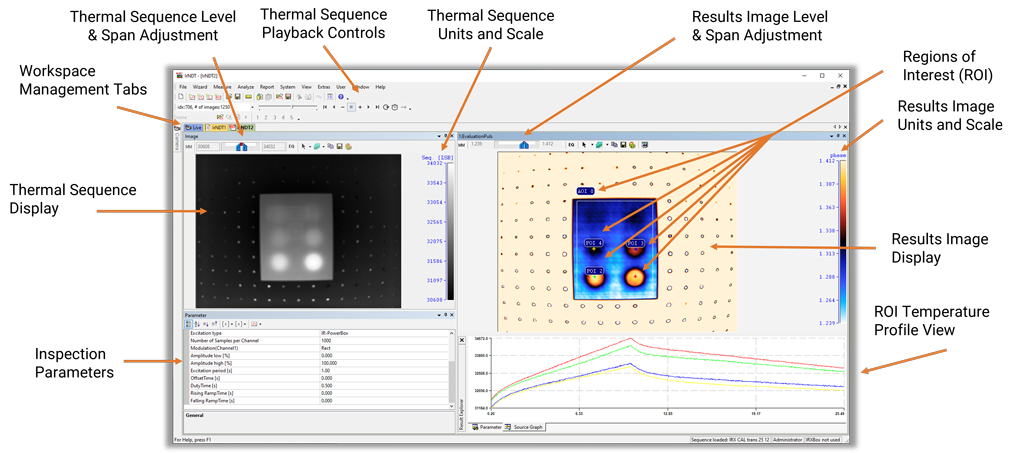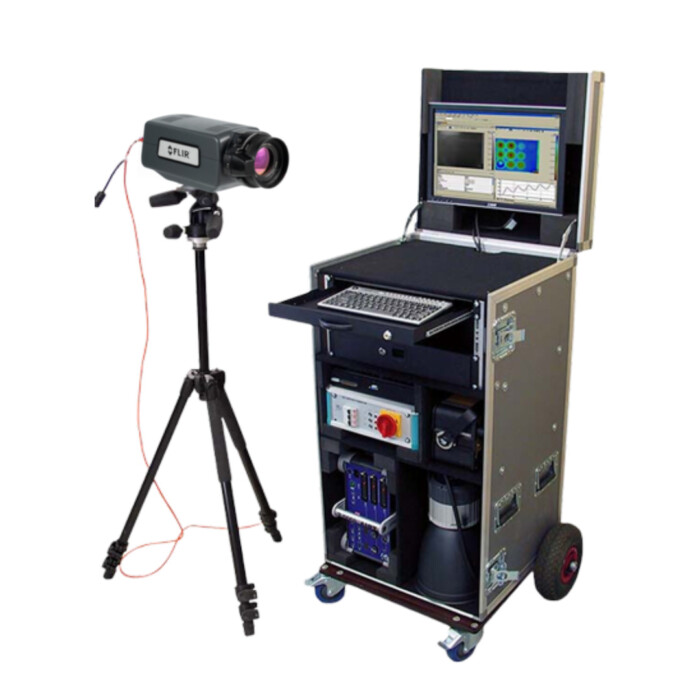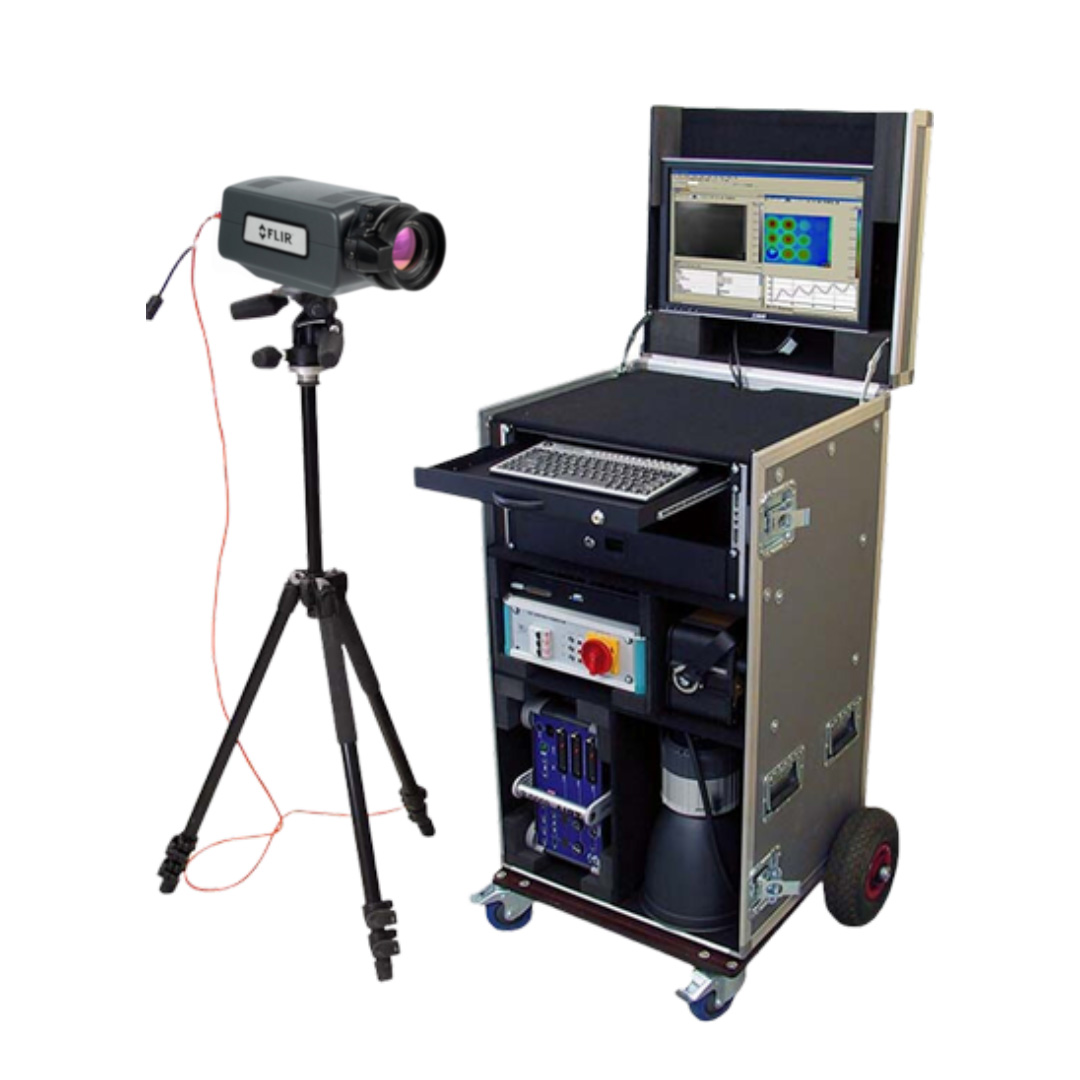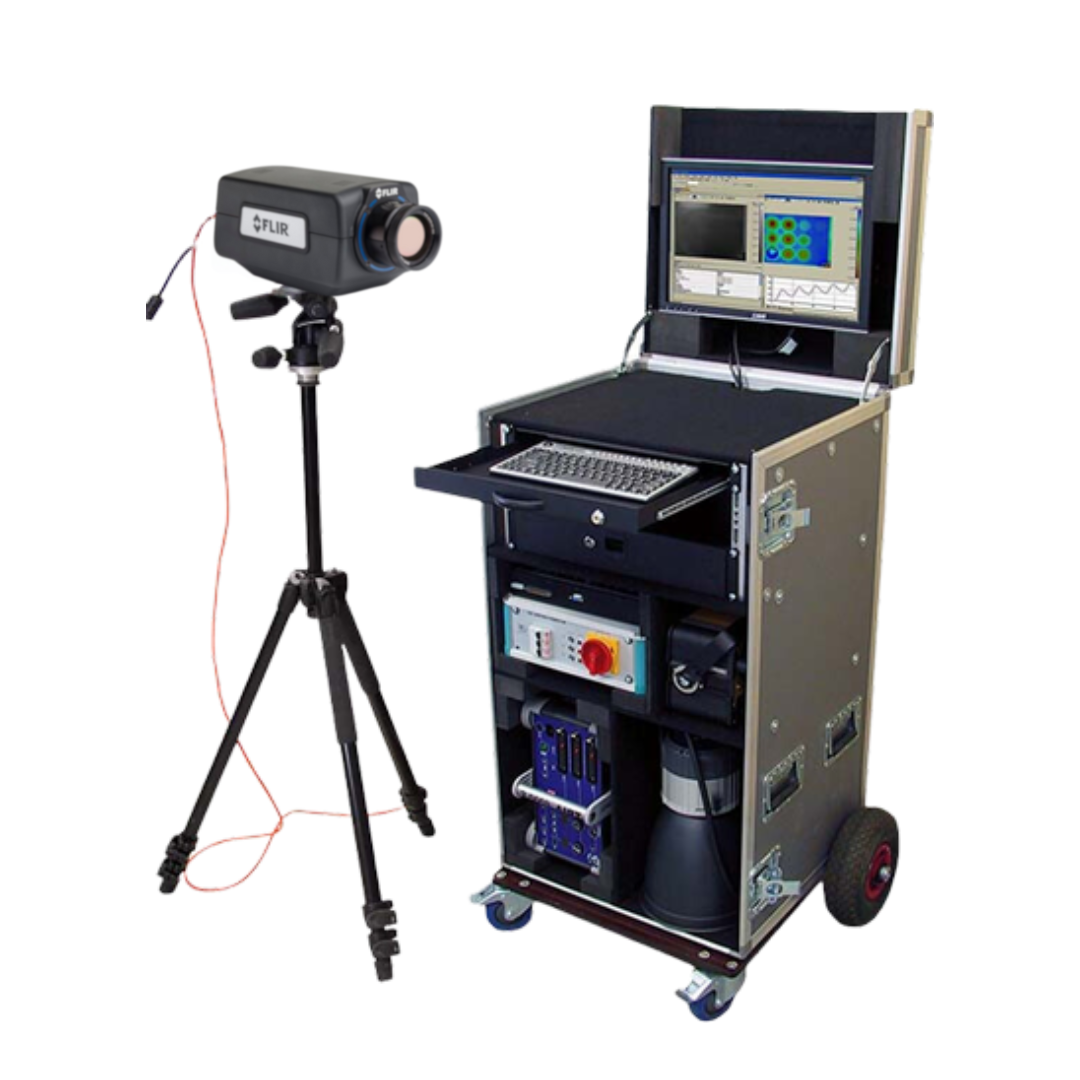FLIR A6780 MWIR Camera + Complete Active Thermography System
FLIR A6780 MWIR Camera + Complete Active Thermography System
Guaranteed safe & secure checkout

*We also accept ACH/wire transfer, checks, and purchase orders.
MoviTHERM’s FLIR A6780 MWIR Camera non‐destructive testing systems use active thermography for the reliable detection of delaminations, impact damages, “near side” defects, water inclusions, debondings, and other defects. The system achieves precise measurements and is ideal for inspecting composites, metals, semiconductors, microelectronics, batteries, ceramics, and more.
Our irNDT system accommodates a wide range of irNDT measurement methods, including: Flash‐Thermography, Lock‐In Thermography, Transient Thermography, and Vibro‐Thermography. It also works with multiple excitation sources and with cooled or uncooled infrared camera systems.
Documentation
Specifications
| FLIR A6780 MWIR Camera Specifications | |
|---|---|
| Resolution | 640 × 512 |
| Pixel size [square] | 15 µm |
| Spectral range | 1.0 – 5.0 µm |
| Detector type | FLIR indium antimonide (InSb) |
| Camera f-number | f/2.5 |
| Dynamic range | 14-bit |
| Frame rate [full window] | Programmable; 0.0015 Hz to 125 Hz |
| Integration time | 480 ns to ~full frame |
| Standard temperature range [with band matched optics] | -20°C to 300°C (-4°F to 572°F) |
| Optional temperature range [with band matched optics] | 45°C to 600°C/113°F to 1112°F (ND1); 250°C to 2000°C/482°F to 3632°F (ND2); 500°C to 3000°C/932°F to 5432°F (ND3) |
| Filter holder [warm] | 3-position motorized filter wheel (1 inch diameter filters) |
| Focus | Motorized (compatible with manual) |
| Imaging & Optical | |
| Available lenses | Manual (broadband): 25 mm, 50 mm, 100 mm |
| Camera f-number | f/2.5 |
| Close-up lenses/microscopes | No microscopes available |
| Detector type | FLIR indium antimonide (InSb) |
| Dynamic range | 14-bit |
| Filter holder [warm] | 3-position motorized filter wheel (1 inch diameter filters) |
| Focus | Motorized (compatible with manual) |
| Frame rate [full window] | Programmable; 0.0015 Hz to 125 Hz |
| Image time stamp | Yes |
| Integration time | 480 ns to ~full frame |
| Lens interface | FLIR FPO-M (4-tab bayonet, motorized) |
| On camera image storage | None |
| Operability | ≥99.8% (≥99.95% typical) |
| Overlay | Fixed configuration, can be turned off |
| Palette | Selectable 8-bit |
| Pixel clock | 50 MHz |
| Pixel size [square] | 15 µm |
| Radiometric data streaming | Gigabit Ethernet (GigE Vision) |
| Readout modes | Asynchronous integrate while read, asynchronous integrate then read |
| Readout type | Snapshot |
| Resolution | 640 × 512 |
| Sensor cooling | Closed-cycle rotary |
| Spectral range | 1.0 – 5.0 µm |
| Standard video | SDI |
| Standard video zoom | Automatic, variable |
| Subwindow modes | Flexible windowing down to 16 × 4 (steps of 16 columns, 4 rows) |
| Thermal sensitivity_NETD [typical] | ≤25 mK (typical) |
| Video modes | SDI: 720p at 50/59.9, 1080p at 25/29.9 |
| Measurement & Analysis | |
| Accuracy | ≤100°C (≤212°F), ±2°C (±3.6°F) accuracy (±1°C/1.8°F typical); >100°C ±2% of reading (±1% typical) |
| Ambient drift compensation [with factory cal] | Yes |
| Automatic gain control | Manual, linear, plateau equalization, DDE |
| Optional temperature range [with band matched optics] | 45°C to 600°C/113°F to 1112°F (ND1); 250°C to 2000°C/482°F to 3632°F (ND2); 500°C to 3000°C/932°F to 5432°F (ND3) |
| Standard temperature range [with band matched optics] | -20°C to 300°C (-4°F to 572°F) |
| Communication & Data Storage | |
| Command and control | GenICam (GigE), RS-232 |
| Synchronization modes | Sync In, Sync Out |
| General | |
| Size [L × W × H] without lens | 226 × 102 × 109 mm (8.9 × 4.0 × 4.3 in) |
| Weight [without lens] | 2.3 kg (5 lbs) |
| Power | |
| Power | 24 VDC (<24 W steady state) |
| Environmental & Certifications | |
| Detection zones | 40 g, 11 msec ½ sine pulse/4.3 g RMS random vibration, all 3 axes |
| Mounting | 2 × ¼” -20 tapped holes, 1 × 3/8″-16 tapped hole, 4 × 10-24 tapped holes |
| Operating temperature range | -20°C to 50°C (-4°F to 122°F) |
Description
FLIR A6780 MWIR Camera – Science-Grade MWIR InSb Camera
The FLIR A6780 MWIR camera system makes it easy to measure temperatures of rapid thermal events and fast-moving targets, making it an ideal choice for industrial, military, and manufacturing R&D applications. This affordable, cooled InSb camera offers the flexibility of both manual and remote-focus lens options to maximize the number of measurement pixels on the object of interest.
And single cable connectivity using Gigabit Ethernet provides complete camera control plus data capturing in FLIR Research Studio software – so users can analyze and understand data faster than ever before.
- Measure Temperature Accurately: Offers sub-windowed frame rates up to 4,130 Hz, a suite of lens options, and a built-in 3-position warm filter wheel to quickly switch between standard and high-temperature ranges.
- Simple Connections, Minimal Ramp-Up Time: Control the camera and stream data using a single Gigabit Ethernet cable; capture the data you want when you want it thanks to advanced triggering and synchronization capabilities.
- Simplified Analysis & Sharing: FLIR Research Studio’s simple Connect–View–Record–Analyze workflow helps you collect and analyze data quickly and collaborate with your team easily.
About the Active Thermography System
MoviTHERM’s FLIR A6780 MWIR non‐destructive testing systems use active thermography for the reliable detection of delaminations, impact damages, “near side” defects, water inclusions, debondings, and other defects. The system achieves precise measurements and is ideal for inspecting composites, metals, semiconductors, microelectronics, batteries, ceramics, and more.
Our irNDT system accommodates a wide range of irNDT measurement methods, including: Flash‐Thermography, Lock‐In Thermography, Transient Thermography, and Vibro‐Thermography. It also works with multiple excitation sources and with cooled or uncooled infrared camera systems.
Features:
- Non‐contact irNDT
- Works with cooled and uncooled IR Cameras
- Compatible with multiple irNDT methods
- Effective even on low emissivity targets
- Modular hardware and software
- Configurable for different geometries and materials
What is Active Thermography?
Active thermography is an effective method for non-destructive testing of materials involving the induction of heat flow in a test object by external excitation. The heat flow within the test object is influenced by internal conditions and measured on the surface by an IR camera. This technique detects not only the smallest surface defects, but also internal structural defects under the surface.
Active vs Passive Thermography
Active and passive thermography are techniques used for detecting heat patterns and abnormalities in various applications. While passive thermography relies on naturally occurring temperature changes, active thermography introduces an external energy source to create thermal contrast.
How does the system work?
MoviTHERM’s modular irNDT system works by utilizing active thermography. A heat source provides the inspected material with a thermal excitation. The flow of thermal energy through the material has a direct effect on surface temperatures. The surface temperature is recorded over a certain time period with an infrared camera and analyzed by the irNDT software.
The software produces an image that provides information about the internal structure of the material.
- Non-Contact Defect Detection: Active thermography reveals the most subtle defects that are visibly undetectable.
- Flexible & Expandable: Upgrade a system by adding excitation sources, irNDT methods, and higher end IR cameras.
- irNDT Made Easy: Complex analysis technology is simplified for dependable inspection results.
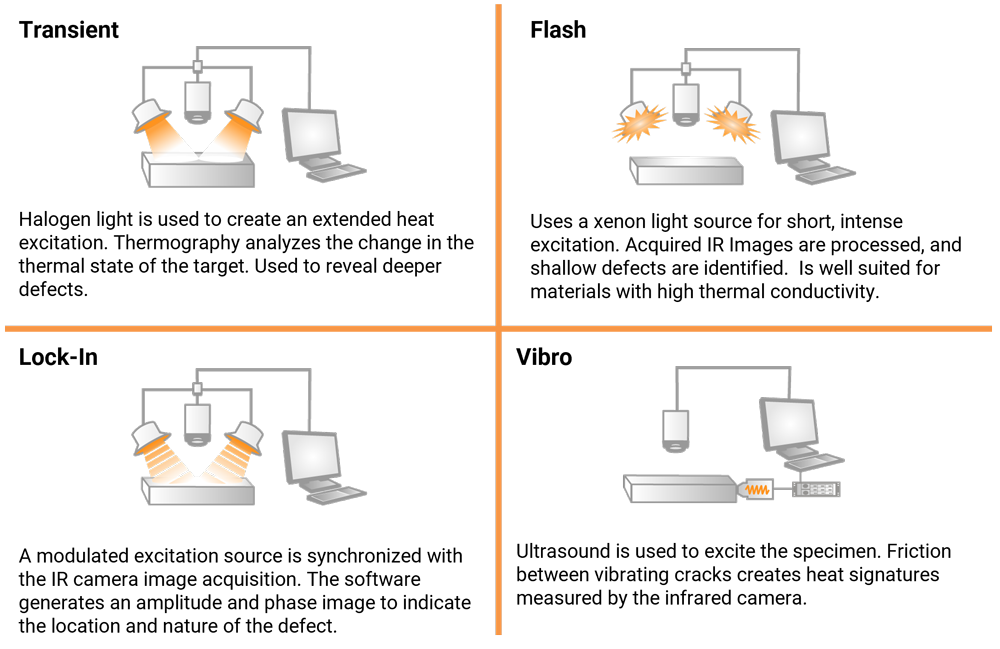
The Software Interface
